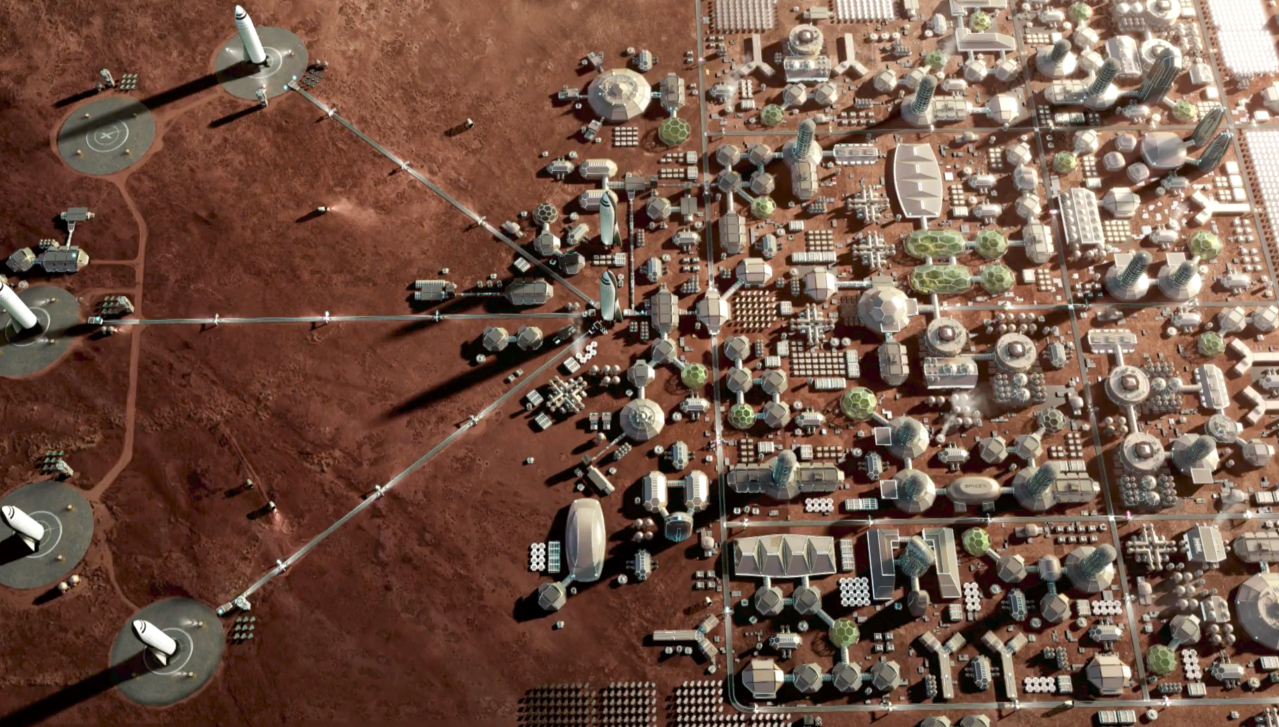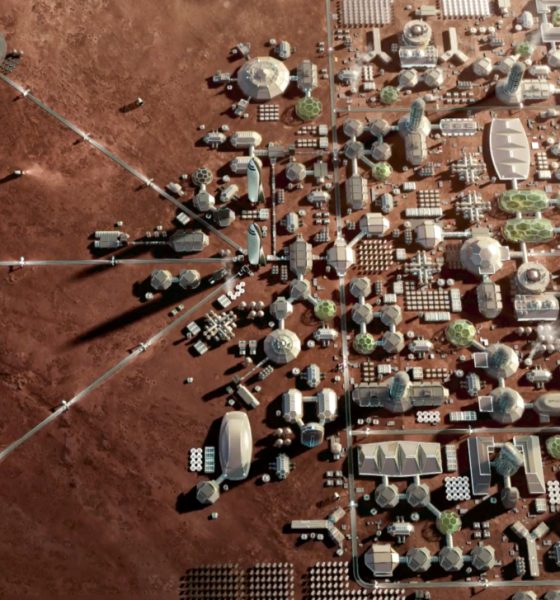

News
New plasma technology could help SpaceX colonize Mars
Elon Musk’s vision of establishing a human settlement on Mars just became a lot more feasible, after a study conducted by a team of Portuguese-French scientists concluded that plasma technology could help foster the production of oxygen on the Red Planet’s atmosphere.
The recent study, published in the Plasma Sources Science and Technology journal, asserts that the prevalence of carbon dioxide in Mars’ atmosphere is actually ideal for the creation of oxygen. According to University of Lisbon researcher Vasco Guerra, the carbon dioxide-rich state of the planet’s atmosphere provides the perfect conditions for creating oxygen through decomposition.
In a statement to Astrowatch.net, Guerra noted that the use of low-temperature plasma decomposition would benefit both Mars’ inhabitants and those traveling to and from the planet.
“Our main conclusion is precisely that Mars has nearly ideal conditions for creating oxygen from carbon dioxide by non-thermal plasmas. Carbon dioxide decomposition can provide oxygen for breathing and contribute to the production of fuels to be used on the return trip to Earth,” Guerra said, according to Astrowatch.net.
RELATED: Here’s what will happen to Elon Musk’s Mars-bound Tesla Roadster
As noted in the findings of the researchers, the production of oxygen on the Red Planet would be done in-situ, which is ideal considering that Mars’ atmosphere is about 95.9 percent carbon dioxide. This CO2 which could then be converted into oxygen and carbon monoxide, the latter of which will be utilized in the production of propellant for rocket vehicles. The low general temperature in the Red Planet, which is -82 degrees Fahrenheit on average, is also perfect for the decomposition of carbon dioxide.
“The pressure and temperature ranges in the about 96 percent carbon dioxide Martian atmosphere favor the vibrational excitation and subsequent up-pumping of the asymmetric stretching mode, which is believed to be a key factor for an efficient plasma dissociation, at the expense of the excitation of the other modes.”
Plasma technologies for CO2 reforming currently utilize solid oxide electrolyzer cells (SOEC). Considering the conditions on the Red Planet, however, the researchers mentioned in their conclusion that a non-equilibrium plasma process should be far more power-efficient and effective in producing oxygen than conventional SOEC. Guerra, however, noted that despite the promising results of his team’s study, more research is needed in order to implement technology that can be used in future interplanetary missions.
“Assuming we have the means to keep developing the technology, a time frame of about five years to have it ready seems realistic. Then we would need to add the time to prepare an actual mission,” Guerra said.
As we mentioned in a previous report, CEO Elon Musk stated that SpaceX is attempting to begin the construction of the first Big Falcon Rocket (BFR), a pivotal spacecraft in the private space firm’s Mars initiative, sometime this year. SpaceX is also aiming to send two cargo spaceships on a Mars-bound mission by 2022.

News
Tesla FSD fleet is nearing 7 billion total miles, including 2.5 billion city miles
As can be seen on Tesla’s official FSD webpage, vehicles equipped with the system have now navigated over 6.99 billion miles.

Tesla’s Full Self-Driving (Supervised) fleet is closing in on almost 7 billion total miles driven, as per data posted by the company on its official FSD webpage.
These figures hint at the massive scale of data fueling Tesla’s rapid FSD improvements, which have been quite notable as of late.
FSD mileage milestones
As can be seen on Tesla’s official FSD webpage, vehicles equipped with the system have now navigated over 6.99 billion miles. Tesla owner and avid FSD tester Whole Mars Catalog also shared a screenshot indicating that from the nearly 7 billion miles traveled by the FSD fleet, more than 2.5 billion miles were driven inside cities.
City miles are particularly valuable for complex urban scenarios like unprotected turns, pedestrian interactions, and traffic lights. This is also the difference-maker for FSD, as only complex solutions, such as Waymo’s self-driving taxis, operate similarly on inner-city streets. And even then, incidents such as the San Francisco blackouts have proven challenging for sensor-rich vehicles like Waymos.
Tesla’s data edge
Tesla has a number of advantages in the autonomous vehicle sector, one of which is the size of its fleet and the number of vehicles training FSD on real-world roads. Tesla’s nearly 7 billion FSD miles then allow the company to roll out updates that make its vehicles behave like they are being driven by experienced drivers, even if they are operating on their own.
So notable are Tesla’s improvements to FSD that NVIDIA Director of Robotics Jim Fan, after experiencing FSD v14, noted that the system is the first AI that passes what he described as a “Physical Turing Test.”
“Despite knowing exactly how robot learning works, I still find it magical watching the steering wheel turn by itself. First it feels surreal, next it becomes routine. Then, like the smartphone, taking it away actively hurts. This is how humanity gets rewired and glued to god-like technologies,” Fan wrote in a post on X.
News
Tesla starts showing how FSD will change lives in Europe
Local officials tested the system on narrow country roads and were impressed by FSD’s smooth, human-like driving, with some calling the service a game-changer for everyday life in areas that are far from urban centers.

Tesla has launched Europe’s first public shuttle service using Full Self-Driving (Supervised) in the rural Eifelkreis Bitburg-Prüm region of Germany, demonstrating how the technology can restore independence and mobility for people who struggle with limited transport options.
Local officials tested the system on narrow country roads and were impressed by FSD’s smooth, human-like driving, with some calling the service a game-changer for everyday life in areas that are far from urban centers.
Officials see real impact on rural residents
Arzfeld Mayor Johannes Kuhl and District Administrator Andreas Kruppert personally tested the Tesla shuttle service. This allowed them to see just how well FSD navigated winding lanes and rural roads confidently. Kruppert said, “Autonomous driving sounds like science fiction to many, but we simply see here that it works totally well in rural regions too.” Kuhl, for his part, also noted that FSD “feels like a very experienced driver.”
The pilot complements the area’s “Citizen Bus” program, which provides on-demand rides for elderly residents who can no longer drive themselves. Tesla Europe shared a video of a demonstration of the service, highlighting how FSD gives people their freedom back, even in places where public transport is not as prevalent.
What the Ministry for Economic Affairs and Transport says
Rhineland-Palatinate’s Minister Daniela Schmitt supported the project, praising the collaboration that made this “first of its kind in Europe” possible. As per the ministry, the rural rollout for the service shows FSD’s potential beyond major cities, and it delivers tangible benefits like grocery runs, doctor visits, and social connections for isolated residents.
“Reliable and flexible mobility is especially vital in rural areas. With the launch of a shuttle service using self-driving vehicles (FSD supervised) by Tesla in the Eifelkreis Bitburg-Prüm, an innovative pilot project is now getting underway that complements local community bus services. It is the first project of its kind in Europe.
“The result is a real gain for rural mobility: greater accessibility, more flexibility and tangible benefits for everyday life. A strong signal for innovation, cooperation and future-oriented mobility beyond urban centers,” the ministry wrote in a LinkedIn post.
News
Tesla China quietly posts Robotaxi-related job listing
Tesla China is currently seeking a Low Voltage Electrical Engineer to work on circuit board design for the company’s autonomous vehicles.

Tesla has posted a new job listing in Shanghai explicitly tied to its Robotaxi program, fueling speculation that the company is preparing to launch its dedicated autonomous ride-hailing service in China.
As noted in the listing, Tesla China is currently seeking a Low Voltage Electrical Engineer to work on circuit board design for the company’s autonomous vehicles.
Robotaxi-specific role
The listing, which was shared on social media platform X by industry watcher @tslaming, suggested that Tesla China is looking to fill the role urgently. The job listing itself specifically mentions that the person hired for the role will be working on the Low Voltage Hardware team, which would design the circuit boards that would serve as the nervous system of the Robotaxi.
Key tasks for the role, as indicated in the job listing, include collaboration with PCB layout, firmware, mechanical, program management, and validation teams, among other responsibilities. The role is based in Shanghai.
China Robotaxi launch
China represents a massive potential market for robotaxis, with its dense urban centers and supportive policies in select cities. Tesla has limited permission to roll out FSD in the country, though despite this, its vehicles have been hailed as among the best in the market when it comes to autonomous features. So far, at least, it appears that China supports Tesla’s FSD and Robotaxi rollout.
This was hinted at in November, when Tesla brought the Cybercab to the 8th China International Import Expo (CIIE) in Shanghai, marking the first time that the autonomous two-seater was brought to the Asia-Pacific region. The vehicle, despite not having a release date in China, received a significant amount of interest among the event’s attendees.








